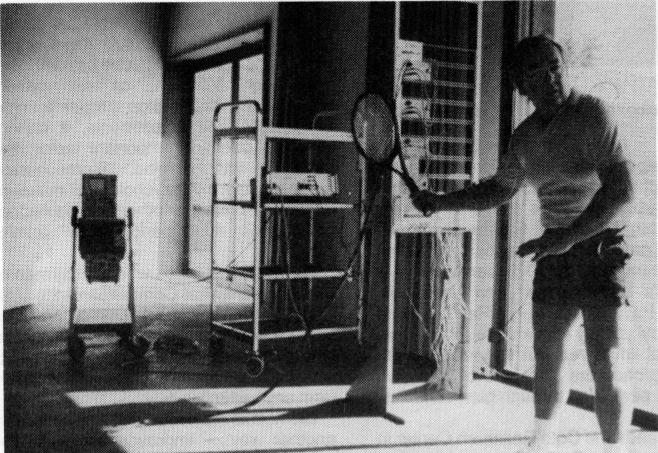| Previous | Index |
"Computers will help improve the quality of players and,
as a result, there isn't a single record that couldn't be broken. "
facturing techniques for sports equipment. Balls will bounce truer. Clubs will swing more effortlessly. Shoes will absorb more shock.
"Biomechanics will help create better equipment to reduce injuries and improve performance, and thus give the athlete a small but vital edge," said Dr. Peter Cavanagh, professor of biomechanics at Penn State University.
If a newly-designed shoe could make a marathon runner one-half of one percent more efficient, it could turn him from an also-ran into a champion, Dr. Cavanagh
added.
But you won't have to be in the starting backfield of the San Francisco FortyNiners or another Bruce Jenner to take advantage of biomechanics.
As a weekend athlete in the year 2001, you can head for the nearest biomechanics analysis center where your athletic performance and movements are measured and problems diagnosed by com
puter. Armed with this knowledge, you make some simple adjustments and - BINGO! You serve harder, throw faster or drive a golf ball further.
Even if your only workout is with a can of beer while watching sports on TV, you will experience the effects on sports of this technology in the next century. Sports coverage as you know it today will be as antiquated as was listening to a staticmarred broadcast of the 1940 World Series on a Crosley.
Joseph Deken, author of The Electronic Cottage, predicts: "The home computer user's display screen would provide a bank of selectable channels to display information from perhaps 30 simultaneous 'chalk talks.' As an added feature to sports coverage, extra channels could bring in a play-by-play transcript of the game, electronic 'scratch-pads' from coaches who diagram and analyze key plays and statistical data and summaries with predictions of all sorts of odds."
Computers will play another big role in the sports scene - as a special assistant coach. Computers already help college and pro teams in processing everything from scouting reports and draft picks to pass patterns. But in the near future, a computer technician might well be the most valuable member of the team.
With the tickling of his computer keyboard, for example, the technician could help vault a cellar-dwelling baseball team into a pennant contender, claims Earnshaw Cook, co-author of Percentage Baseball and the Computer.
After being fed more than 750,000 statistics from about 12,000 games, Cook's computer came up with this 21st Century baseball strategy: Scrap the sacrifice bunt and go with the hit-and-run instead. Never steal with two outs nor issue an intentional walk. Start the game with a relief pitcher for the first two innings, then bring in the regular starter for the next five and finish off the final two innings with another reliever. Arrange the batting order according to the players' batting average, leading off with the best.
Purists may moan like a sore-armed pitcher, but computers are here to stay. Says Dr. Deken, "There's no reason why any high school football coach can't use computer technology to adapt his team's play offensively and defensively to the analyzed strengths and weaknesses and patterns of the opponent."
The Dallas Cowboys are doing just that and have been for some time. "Pro teams will have to go the way of the Cowboys if they want to win," says Gideon Ariel. "We've just developed a program called formation analysis. The computer detects weaknesses in the opposing team based on the position of the player, his physical strength and speed and reaction time. The computer simulates in game conditions how the opposing player will move and react on a given play."
The Cowboys' conditioning coach, Bob Ward, doubts that computers will really take over the game. "We'll use them to develop better game plans and educate our players about the opposing team. But in the final analysis, computers don't play the game. Humans do - and always will."
- Allan Zullo
Tennis pro Vic Braden, hooked to a computer by electrodes, demonstrates how movement and muscle response can be tested to improve play.
SKY July 1982

| Previous | Index |